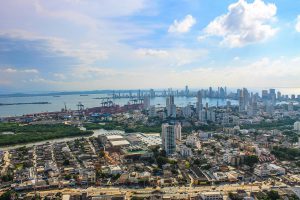Colombia is the only country in South America with access to both the Pacific and Atlantic Oceans. Yet the Colombian government has never taken advantage of this unique position to boost economic development. But now Chinese investors are looking to fix this.
The country has historically favoured trade infrastructure along the Caribbean coast in cities like Barranquilla, Santa Marta and Cartagena. These offer easy access to its most important trade partners: the US and Europe. But as Asian markets grow, Colombia is looking to pivot towards the Pacific.
Ambitious development
The star project it is hoped will kick-start the development of Colombia’s Pacific coast is the Economic Activities Centre in Buenaventura (CAEB).
The CAEB is the National Planning Department’s remedy for Buenaventura’s chronic economic malaise. It’s the pilot project for its ambitious New Cities Program, which seeks to create new economic centres around the country and generate growth in the post-peace deal era. The centre’s promise stems from the rapid growth of cities like Shenzen, China. It aims to capitalise on Buenaventura port’s dynamism to stimulate economic activity between Colombia and Pacific trading partners.
The Buenaventura port is Colombia’s most important link to international markets, generating 27% of the country’s total customs revenue. The port’s potential to facilitate trade with Latin American partners is enormous given its equidistance between Mexico and Chile.
Until now, the growth of the port has generated few economic benefits for the city of Buenaventura itself. “Buenaventura isn’t a port city, it’s a city that happens to be next to a port,” says Julio Cesar Alonso, director of the Research Centre in Economics and Finance at the ICESI University in the western city of Cali.
According to Alonso, extreme poverty and low levels of employment and industry mean that the Buenaventura city government collects little revenue from tax. The central government has not invested in the city either so it’s been unable to develop the infrastructure that port-related businesses need to survive. Wealth generated by the port tends to get reinvested in other cities with better infrastructure, like Cali and even the capital Bogotá, some 500 kilometres away. “Any investment to develop in the Pacific coast must be linked with a social strategy,” Alonso says, adding that only by eradicating poverty can this project be a success for its investors.
The CAEB aims to lift thousands out of poverty and put Buenaventura on the world map by allocating vast areas to residential, industrial, scientific, and technological development. Revamping infrastructure for roads, water and electricity is also central.
Interest from China
This model seemed attractive enough for the governments of China and Colombia to sign a memorandum of understanding in which China expressed its intent to invest around US$16 million in the project.
To date, there is little Chinese investment in Colombia compared to neighbouring countries such as Ecuador and Venezuela. However, as peace deal negotiations with guerrilla group the Revolutionary Armed Forces of Colombia (FARC) progressed, interest in new infrastructure projects increased.
Colombia’s economic relations with China are taking on a new significance as the latter revises its investment portfolio in the wider region. China’s financial exposure to struggling economies such as Venezuela and Ecuador is high because their ability to repay Chinese loans backed by the sale of oil is constrained by low prices. Investors are increasingly looking to help Latin American partners develop industrial sectors beyond those producing raw materials in order to help them move up the value chain.
Alonso, says that under the proposed CAEB model, a Chinese car manufacturing company would receive tax incentives to establish an assembly plant in Buenaventura. Aside from creating local employment, it would also benefit from cheaper shipping costs throughout the Americas. By investing in the CAEB, the Chinese government could create a new launch pad for Chinese businesses in Colombia, and the wider South America region.
The project is still in the initial planning stages but the Colombian government deems it important enough to have appointed its first manager, Buenaventura native Didier Sinisterra. “It’s true that Buenaventura is years behind other port cities like Panama,” Sinisterra told Diálogo Chino via telephone from Washington DC, from where he will return to Buenaventura to spearhead the project. Sinisterra has faith in the project’s ability to transform Buenaventura. “Through this project Buenaventura will become a world class city able to compete with others like Singapore,” he claims.
However, there are underlying issues surrounding the project. One of the most pressing is the security threat. Buenaventura has been engulfed in violence associated with Colombia’s decades-long conflict and which still persists today. Illegal mining and drug trafficking have not ceased since the historic signing of the peace accord with FARC. Moreover, illegal armed groups, most of them consisting of paramilitaries who did not demobilise under former president Alvaro Uribe’s demobilisation plan, are fighting to fill the power vacuum the FARC has left behind.
The CAEB offers a potential economic solution to the difficult security situation in Buenaventura. The city suffers from a 62% unemployment rate and many Buenaventurans rely on illegal activities to survive.
Earlier this year, Buenaventura residents expressed their desperation in one of the biggest protests Colombia has seen in recent years. Protestors demanded an improvement in security, more jobs and greater access to drinking water.
In response, the government pledged millions of dollars towards better education, health, and electricity access, as well as water infrastructure.
Some protest leaders oppose the CAEB, demanding that the government prioritise the city’s more pressing needs. The government has committed to improve basic living conditions but suggests Buenaventura’s main problem is unemployment, something Sinisterra says the CAEB project can address. “The project will create 150 companies in 20 years, and more than 60,000 jobs,” he says. “Those figures make it clear that this is a project for the community.”
Land ownership
Chinese investors must also contend with complex land ownership where the project is set to be built. Colombian law recognises the rights of black and indigenous minorities, who typically organise into community councils, thereby giving them authority and collective ownership over the territories they inhabit. As home to a large African diaspora around the time Colombia achieved independence in the early 19th century, the Pacific coast accommodates many such councils. Some 70% of the land the CAEB would occupy is owned by two of these councils, known as the Caucana and Gamboa.
For a project like the CAEB to materialise, the government must first consult the councils, which collectively own the land. The territories occupied by these councils are all in rural Colombia, which is notoriously underdeveloped compared to urban centres. Consultations often resemble negotiations in which the councils make demands for infrastructure such as schools and hospitals before they grant approval.
However, the CAEB will conduct things differently. It will be the first infrastructure project to make business associates out of these community councils, which will input into the development of the project.
The Gamboa and Caucana councils have already approved the project but in March 2017 a judge annulled the community councils’ land ownership titles, as the ownership is disputed by another council called Bahia Malaga. A long appeals process has started, with a final ruling expected in around five years. If the councils lose the appeal, they would still have the power to negotiate in a consultation process, even though the land would become the property of the national government.
Representatives at the Foundation for the Integral Development of the Colombian Pacific Region, a non-governmental organisation working for sustainable development on Colombia’s Pacific coast, say the concept of community councils and their right to the land they inhabit has been very hard to explain to the Chinese government.
They fear Chinese investors will be deterred by the time it will take to resolve this issue. But the Colombian government is looking for a solution. As it waits for the final ruling, it has commissioned a new zoning plan for Buenaventura and the CAEB. It has also directed the national registry agency to conduct an audit of land around the project so that it can commission a feasibility plan to present to foreign investors.
In May this year, Chinese delegations visited the site of the CAEB. Their assessment of the project’s costs and benefits could determine whether it will offer an economic alternative to illegal activities and a unique opportunity to empower disenfranchised black communities in a region plagued by conflict and poverty.








